
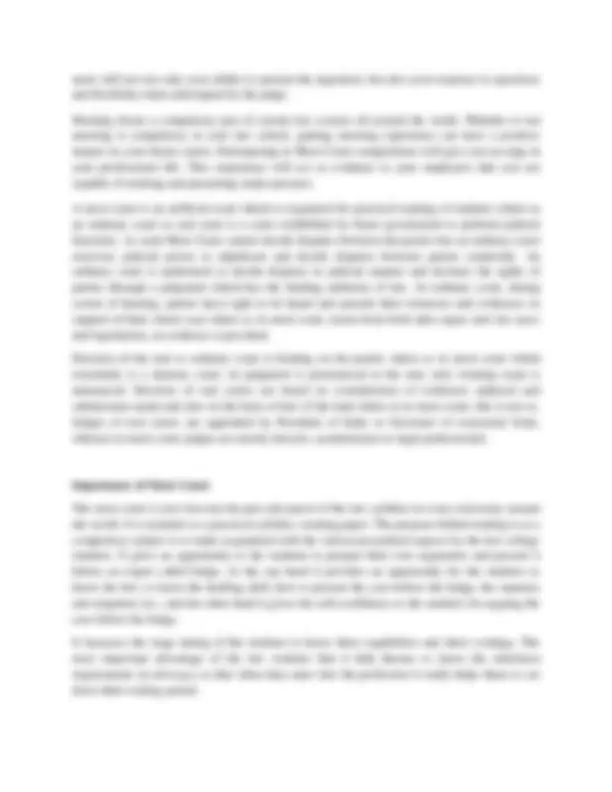
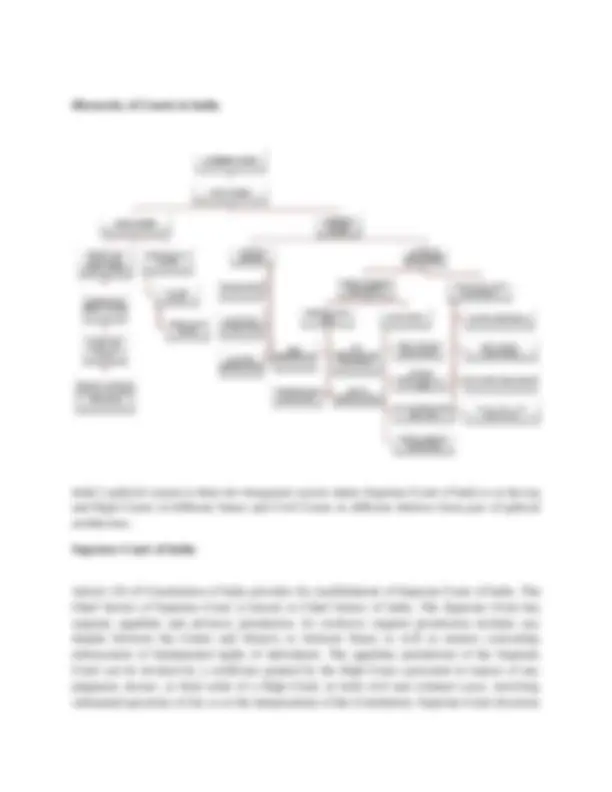
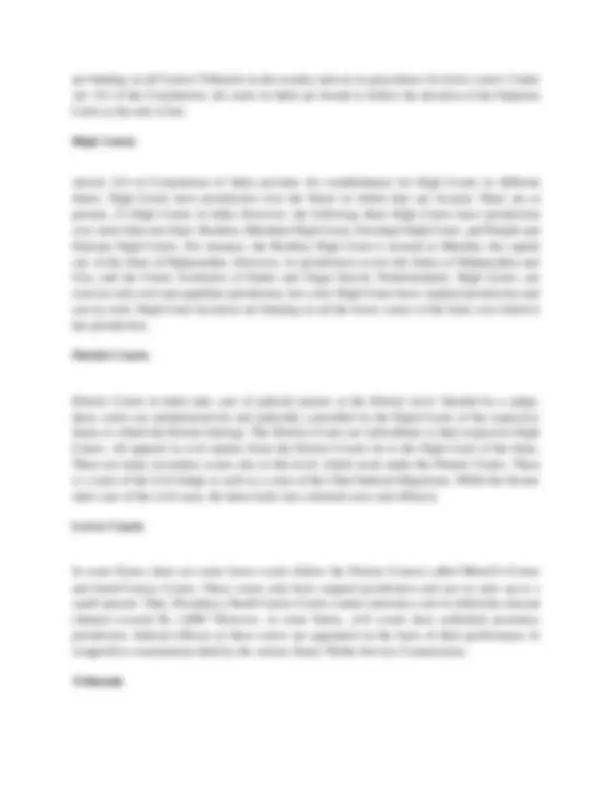
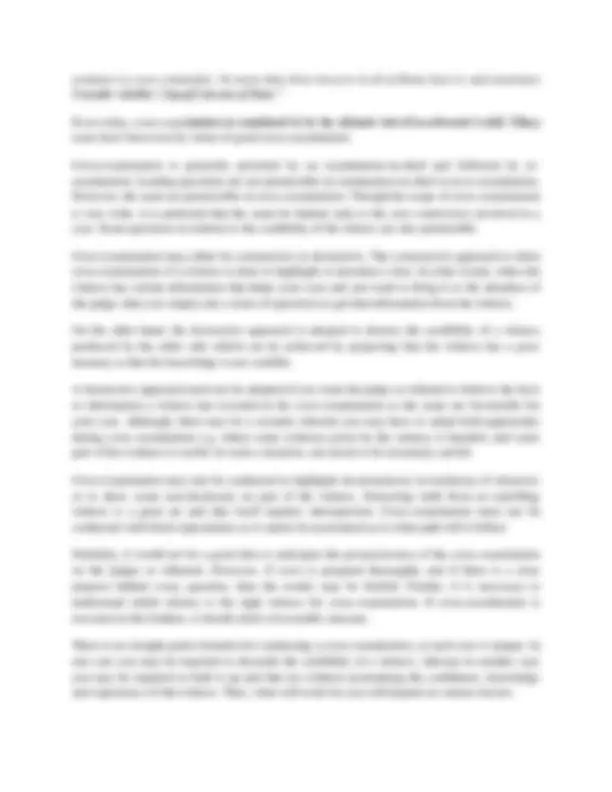
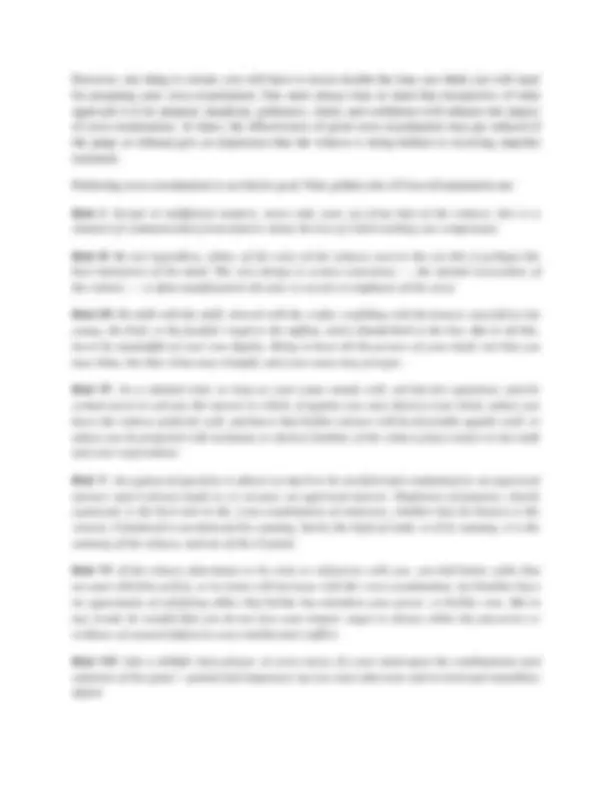

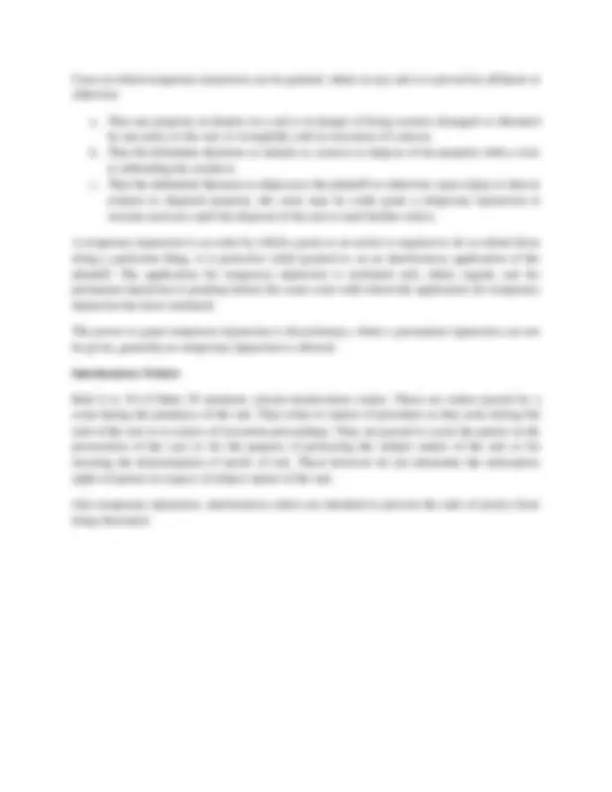


Study with the several resources on Docsity

Earn points by helping other students or get them with a premium plan


Prepare for your exams
Study with the several resources on Docsity

Earn points to download
Earn points by helping other students or get them with a premium plan
Community
Ask the community for help and clear up your study doubts
Discover the best universities in your country according to Docsity users
Free resources
Download our free guides on studying techniques, anxiety management strategies, and thesis advice from Docsity tutors
Detailed overview of moot court & court management.
Typology: Lecture notes
1 / 13

This page cannot be seen from the preview
Don't miss anything!








The word ‘Moot’ means to debate or discuss something. Generally the moot courts are organized in law colleges, universities. A moot is an argument on points of law that aims to simulate an appeal court hearing before a judge or panel of judges. The participants, known as ‘mooters’, argue the legal merits of appealing a fictitious case that has been decided in a lower court.
Moot Court is an artificial Court which is especially made for the lawful students to have the practical knowledge of drafting, pleading and conveyancing. In the moot court an artificial problem was given to the students for which they have to prepare their arguments and present it before an expert.
In order to present your moot in a satisfactory and persuasive manner, you will need a thorough understanding of the legal issues involved in the moot problem. To do this properly, you will need to read and understand a significant number of cases and be able to identify and apply the legal principles appropriately in the moot. This can be contrasted with preparing for an exam where, although not recommended, reading a few pages from a student textbook and some headnotes from key cases might just be enough to get you through the earlier stages of your studies. This will not be nearly enough to succeed at mooting. The additional time spent in preparing for a moot can pay dividends in another way. Moot problems, just like exam questions, are often set to reflect topical legal issues, and mooting students frequently report having to spend much less time revising for their exams on topics they have researched for their moots.
There is one important additional point to make. Mooting requires you to engage properly with primary sources of law such as decided cases and statutes rather than relying on the secondary sources of textbooks. Engaging with primary sources helps you to construct your arguments in the same way practising lawyers would construct their arguments, thus enabling you to be creative with your submissions rather than merely repeating what a textbook author has said about a case. Additionally, some moots are written to test a novel point of law where a textbook will be of very limited assistance to you in any event.
Benefits of participating in a Moot Court are following-
Mock Trial
A “mock” trial means a trial acted out by students as if they were trying a case before a judge or jury. Students play all parts in the trial as attorneys, clients, and witnesses. Opening statements, direct and cross examination, and closing arguments are all part of the mock trial. Mock trial, as I mentioned before, is competitive trial advocacy. Competitors simulate a full trial on the merits before the lowest court in the imaginary state or district in which the case’s facts take place. Law school teams consist of four competitors (undergrad teams range from six to 10).
During a given round of competition (the trial), two competitors act as attorneys, and the other two act as witnesses. While witnesses are unscored, they are still incredibly important in assisting their attorney teammates by building rapport with their directing attorney and being polite but unhelpful to the opposing team’s crossing attorney. Generally, competitors play a witness on one side and an attorney on the other. Contrary to popular misconception, the modern moot court differs from a mock trial.
Moot court usually refers to a simulated appellate court or arbitral case, while a mock trial usually refers to a simulated jury trial or bench trial. Moot court does not involve actual testimony by witnesses, cross-examination, or the presentation of evidence, but is focused solely on the application of the law to a common set of evidentiary assumptions to which the competitors must be introduced. In most countries, the phrase “a moot court” may be shortened to simply “a moot” and the activity may be called “mooting”.
Difference between Moot Court and Real Court
Although the moot court is not a real court it reflects a real court room environment requiring the participants to wear uniforms and observe the court room decorum throughout the proceedings and therefore gives you the ultimate insight into the life of a lawyer.
With the opportunity to present your case in front of judge moot courts builds your confidence, which is an essential feature of a successful lawyer. Moot courts provide you with a platform to practice arguments & develop your legal skills such as research and presentation abilities. The
Hierarchy of Courts in India
India’s judicial system is three tier integrated system where Supreme Court of India is at the top and High Courts of different States and Civil Courts in different districts form part of judicial architecture.
Supreme Court of India
Article 124 of Constitution of India provides for establishment of Supreme Court of India. The Chief Justice of Supreme Court is known as Chief Justice of India. The Supreme Court has original, appellate and advisory jurisdiction. Its exclusive original jurisdiction includes any dispute between the Centre and State(s) or between States as well as matters concerning enforcement of fundamental rights of individuals. The appellate jurisdiction of the Supreme Court can be invoked by a certificate granted by the High Court concerned in respect of any judgment, decree, or final order of a High Court, in both civil and criminal cases, involving substantial questions of law as to the interpretation of the Constitution. Supreme Court decisions
are binding on all Courts/ Tribunals in the country and act as precedence for lower courts. Under Art 141 of the Constitution, all courts in India are bound to follow the decision of the Supreme Court as the rule of law.
High Courts
Article 214 of Constitution of India provides for establishment for High Courts in different States. High Courts have jurisdiction over the States in which they are located. There are at present, 2 5 High Courts in India. However, the following three High Courts have jurisdiction over more than one State: Bombay (Mumbai) High Court, Guwahati High Court, and Punjab and Haryana High Courts. For instance, the Bombay High Court is located at Mumbai, the capital city of the State of Maharashtra. However, its jurisdiction covers the States of Maharashtra and Goa, and the Union Territories of Dadra and Nagar Haveli. Predominantly, High Courts can exercise only writ and appellate jurisdiction, but a few High Courts have original jurisdiction and can try suits. High Court decisions are binding on all the lower courts of the State over which it has jurisdiction.
District Courts
District Courts in India take care of judicial matters at the District level. Headed by a judge, these courts are administratively and judicially controlled by the High Courts of the respective States to which the District belongs. The District Courts are subordinate to their respective High Courts. All appeals in civil matters from the District Courts lie to the High Court of the State. There are many secondary courts also at this level, which work under the District Courts. There is a court of the Civil Judge as well as a court of the Chief Judicial Magistrate. While the former takes care of the civil cases, the latter looks into criminal cases and offences.
Lower Courts
In some States, there are some lower courts (below the District Courts) called Munsif's Courts and Small Causes Courts. These courts only have original jurisdiction and can try suits up to a small amount. Thus, Presidency Small Causes Courts cannot entertain a suit in which the amount claimed exceeds Rs 2,000.^2 However, in some States, civil courts have unlimited pecuniary jurisdiction. Judicial officers in these courts are appointed on the basis of their performance in competitive examinations held by the various States' Public Service Commissions.
Tribunals
Usually, after the preliminary hearing and before a criminal case goes to trial, the prosecutor and the defence team appears before a criminal court judge and makes pre-trial motions, arguments about some evidence to be kept out of the trial, that some persons must or cannot testify, or that the case should be dismissed entirely. The term ‘trial’ has not been defined under the code of criminal procedures. The judicial tribunal determines and examines the case. It is a court proceeding that ends with conviction or acquittal but not discharges.
Steps in pre-trial
In India, all criminal cases consist of pre-trial and post-trial stages. To a pre-trial case, the offence must be classified as either cognizable or non-cognizable defined as cognizable crime and non-cognizable crimes, respectively. Cognizable crime means a crime that can be charged without a warrant by a police officer. In the event of cognizable offences, the Police Officer is obliged to file an FIR (First Information Report) under Section 154 of the CrPC immediately and may undertake investigations and acts such as arrest etc. In general, cognizable crimes are extremely severe in nature or situations where immediate action by the police is required.
Cognizable offences can be either bailable or non-bailable as described in Section 2(a) of CrPC. Non-cognizable crime is a crime in respect of which a police officer has no right to arrest without warrant. While FIR does not need to be registered for non-cognizable offences, the same must be entered in a separate register held for that purpose. In these cases, a police officer may initiate an investigation after obtaining permission from the competent court according to Section 155 of CrPC.
The police collect evidence, arrest and produce the accused before the Judge and secure police detention or judicial remand orders. If the police consider that no prima facie case is made out of the final report, the investigation shall be terminated and filled in before the tribunal. If the investigative agency thinks a case is made prima facie, it will prepare a charge sheet which is filed before trial. The Magistrate must pass final orders reporting and charging boards. The case will be depending on the Magistrate’s order either to be dropped or put up for prosecution and trial.
Marcus Tullius Cicero, a Roman statesman, lawyer and academic skeptic philosopher, expressed his views on the art of cross-examination in one of his letters thus:
“…Nothing an advocate does is simple, but of all the things an advocate must do, by far the most difficult, the most complex, and the most subtle is cross-examination.. The talent to cross-
examine is a rare commodity. No more than three lawyers in all of Rome have it, and sometimes I wonder whether I myself am one of them.”
Even today, cross-examination is considered to be the ultimate test of an advocate’s skill. Many cases have been won by virtue of good cross-examination.
Cross-examination is generally preceded by an examination-in-chief and followed by re- examination. Leading questions are not permissible in examination-in-chief or in re-examination. However, the same are permissible in cross-examination. Though the scope of cross-examination is very wide, it is preferred that the same be limited only to the core controversy involved in a case. Some questions in relation to the credibility of the witness are also permissible.
Cross-examination may either be constructive or destructive. The constructive approach is when cross-examination of a witness is done to highlight or introduce a fact. In other words, when the witness has certain information that helps your case and you want to bring it to the attention of the judge, then you simply ask a series of questions to get that information from the witness.
On the other hand, the destructive approach is adopted to destroy the credibility of a witness produced by the other side which can be achieved by projecting that the witness has a poor memory or that his knowledge is not credible.
A destructive approach need not be adopted if you want the judge or tribunal to believe the facts or information a witness has revealed in his cross-examination as the same are favourable for your case. Although, there may be a scenario wherein you may have to adopt both approaches during cross examination e.g. where some evidence given by the witness is harmful, and some part of his evidence is useful. In such a situation, one needs to be extremely careful.
Cross-examination may also be conducted to highlight inconsistencies in testimony of witnesses or to show some non-disclosure on part of the witness. Extracting truth from an unwilling witness is a great art and that itself requires introspection. Cross-examination must not be conducted with fixed expectations as it cannot be ascertained as to what path will it follow.
Similarly, it would not be a good idea to anticipate the persuasiveness of the cross-examination on the judges or tribunals. However, if cross is prepared thoroughly and if there is a clear purpose behind every question, then the results may be fruitful. Further, it is necessary to understand which witness is the right witness for cross-examination. If cross-examination is executed in this fashion, it should yield a favourable outcome.
There is no straight jacket formula for conducting a cross-examination, as each case is unique. In one case you may be required to discredit the credibility of a witness, whereas in another case you may be required to built it up and that too without ascertaining the confidence, knowledge and experience of that witness. Thus, what will work for you will depend on various factors.
Rule VIII. Never undervalue your adversary, but stand steadily upon your guard; a random blow may be just as fatal as though it were directed by the most consummate skill; the negligence of one often cures, and sometimes renders effective, the blunders of another.
Rule IX. Be respectful to the court or the tribunal; kind to your colleagues; civil to your antagonist; but never sacrifice the slightest principle of duty to an overweening deference toward either.
There are times when the witness will give evasive answers or refuse to answer. In that case, it is desirable to seek the intervention of the court. Insofar as objections raised by the counsel for the other side are concerned, if the same are legitimate, then thank the objecting counsel or apologize to the witness and the judge/tribunal and put a better question, as it retains the confidence of the judges. If the objection raised is frivolous or baseless, then defend the question and request the judge or tribunal to intervene.
Incidentally, objections that are raised for protecting or prompting a witness are not taken in good taste by the judges or tribunals. Thus, if your witness is being cross-examined, then it is better not to object to a question unless there is valid ground for raising that objection.
During cross-examination, usage of long, complicated and complex questions must be avoided. In other words, keep the language plain and simple. One must be conscious about not repeating any unfavourable information or facts which the witness has already stated as you will be repeating the facts you don’t want to hear and you don’t want the judge or tribunal to hear.
Most importantly, use leading questions as much as you can as that would give you Yes or No answers which will be useful. Leading questions will give you control as they give you the ability to set the tone and focus of the cross-examination. The reason for avoiding open-ended questions is that the witness has already told his story without interruption in his witness statement or evidence by way of an affidavit. Why do you want to give him that chance again by asking open ended questions?
Also, know when to stop. When you get a favourable response from the witness, do not ask follow up questions, as that would give the witness an opportunity to clarify his previous answer. Thus, stop when you know you have got what you wanted from the witness.
Many lawyers ask questions they themselves don’t know the answers to. As a result, they end up being surprised by the response of the witness, which damages the case. Therefore, it is better to ask the questions you already know the answers to. Moreover, listen to the answers given by the witness very carefully. There may be an answer which can give you an important area to cross- examine and which might turn the whole case in your favour.
Therefore, when you prepare a series of questions in advance, it is not mandatory to stick to that line of questioning and you must change your line of questioning as per the answers given by the
witness. Relate your cross-examination to the theme and theory of the case. Make use of the logical gaps in the statements given by the witness in his affidavit and control the length of your cross-examination and quit when you feel that the witness is giving better answers to your questions. Always remember that a confused witness may give more useful answers, whereas a knowledgeable witness with a good recollection of facts may be very harmful to your case.
At the end of the day, cross-examination is a matter of meticulous determination, hard work and common sense. The structure of a cross-examination should therefore be pre-planned and must be chronological, as it is also very useful for the judge or the tribunal to go step by step through relevant facts of the case.
Suit under Order 37 of Code of Civil Procedure 1908
The term suit is not defined under the C.P.C, 1908. In the comprehensive sense the word suit is understood to apply to any proceeding in a court of justice by which an individual pursues that remedy which the law affords. The summary suit has a faster remedy than the ordinary suit. The term summary suit is a specific legal procedure used for enforcing a right in an effective manner as the courts pass judgment without hearing the defence. While this prima facie would appear to violative of the fundamental principle of natural justice, Audi Alteram Partem, nobody should be condemned unheard, this procedure is only used in certain restricted cases where the defendant has no reasonable defence. Order 37 provides summary procedure in suits restricted to the negotiable instruments or where the plaintiff seeks to recover debt or liquidated amount. Whereas the ordinary suit has don’t have any restriction to certain matters, these suits are filed on the matters which are in civil nature.
Order 37 of Civil Procedure Code provides for the summary procedure. The provision has been made keeping in view certain suits, in order to prevent the unreasonable obstruction laid down by the defendant, who has no defence. Unlike other civil suits, the trial in summary suits begins after the court grants leave to the defendant to contest the suit. The court dealing with summary suits can pass the judgment in the favour of the plaintiff if (1) the defendant has not applied for leave to defend or if such application has been made but refused, or (2) the defendant who is permitted to defend fails to comply with the conditions on which the leave to defend was granted.
Under summary suit, defendant is not allowed to defend his case unless he obtains leave of the court to defend this case. When a leave to defend is not applied or if applied, is not granted by the court, the plaint of the plaintiff is decreed immediately. (Decree is final adjudication of the case or execution of the case) The primary object of Summary Procedure is to prevent unreasonable obstruction by the defendant who has no defence and to expeditious disposal of the case.
Cases in which temporary injunction can be granted: where in any suit it is proved by affidavit or otherwise
a. That any property in dispute in a suit is in danger of being wasted, damaged or alienated by any party to the suit, or wrongfully sold in execution of a decree b. That the defendant threatens or intends to, remove or dispose of his property with a view to defrauding his creditors c. That the defendant threatens to dispossess the plaintiff or otherwise cause injury to him in relation to disputed property, the court may by order grant a temporary injunction to restrain such acts until the disposal of the suit or until further orders.
A temporary injunction is an order by which a party to an action is required to do or refrain from doing a particular thing, it is protective relief granted to on an interlocutory application of the plaintiff. The application for temporary injunction is instituted only where regular suit for permanent injunction is pending before the same court with whom the application for temporary injunction has been instituted.
The power to grant temporary injunction is discretionary, where a permanent injunction can not be given, generally no temporary injunction is allowed.
Interlocutory Orders
Rule 6 to 10 of Order 39 mentions certain interlocutory orders. These are orders passed by a court during the pendency of the suit. They relate to matter of procedure as they arise during the trial of the suit or in course of execution proceedings. They are passed to assist the parties in the prosecution of the case or for the purpose of protecting the subject matter of the suit or for ensuring the determination of merits of suit. These however do not determine the substantive rights of parties in respect of subject matter of the suit.
Like temporary injunction, interlocutory orders are intended to prevent the ends of justice from being frustrated.